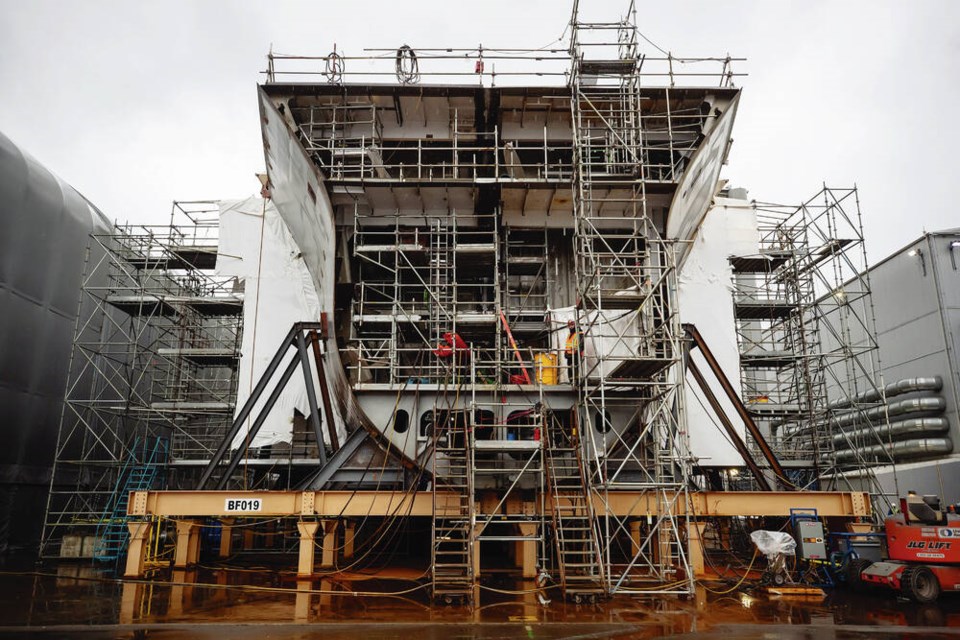In Canada, there are three major active shipyards that have been and are building naval ships — Davie of Quebec, Irving of Halifax, Seaspan of Vancouver.
Davie is the largest naval and most experienced shipbuilder, and it built the largest naval ship delivered from a Canadian shipyard. Fifteen other builders of large naval ships have become inactive in Canada since the Second World War.
In 2010, the Canadian government created the National Shipbuilding Strategy in an effort to restore Canada’s marine industry and shipyards and renew the fleets of the navy and coast guard.
The program was charged with selecting two shipyards capable of rebuilding the two fleets through two large packages of work called a combat ship package and a non-combat ship package.
The combat package was planned for Irving. It includes 23 vessels and is valued at more than $80 billion. Irving is now asking the government for at least $300 million so it can modernize its facilities to build the ships, despite an earlier stipulation that public funds would not be required for such upgrades.
The non-combat package was planned for Seaspan for 30 vessels for the coast guard, including the two joint support ships for the navy.
In September 2015, reports emerged that climbing costs of both packages and shipyard capabilities would cause considerable delays in production, with fears that the joint support ships could be delayed significantly.
In 2019, the government decided to initiate a competition to add a third yard. It was then announced that Davie had qualified for the icebreaker work.
The addition of a third shipyard was said to increase the capacity to deliver new vessels in a timely manner and possibly at a reduced cost. Obviously, the three yards should have been initially contracted to reduce costs and improve the timeline for delivery of ships.
With the Russian invasion of Ukraine, there is a push in both the U.S. and Canada to gear up industry to a “wartime footing” and significantly boost production of weapon systems.
In Canada, Chief of Defence Staff Gen. Wayne Eyre argued that the Russian invasion should be the catalyst for such a major shift in industrial capacity. He noted that Canada needs to increase the capacity of defence industries to support requirements since there is a huge demand. But the reality is that combat systems, especially sophisticated warships, cannot surface overnight.
The Defence Department has indicated it is ready to pump billions of dollars more into the defence industry. Given the long lead time for shipbuilding there is now a critical shortage in this industry.
With only three shipyards capable of building or repairing large ships, it is imperative that the government invest in a fourth shipyard.
Since the end of the Second World War, 15 Canadian shipyards have become inactive. Some of these yards were known for their expertise in building naval assets, for example Saint John Shipbuilding, which built nine of today’s patrol frigates.
There was also the Victoria Machinery Depot, which did essential shipyard work in both world wars and built warships in the early 1960s. Two naval destroyers were built there, HMCS Terra Nova in 1959 and HMCS Saskatchewan in 1961.
Fifteen ferries were also built for B.C. Ferries by this yard. During 1965-1967, Victoria Machinery Depot constructed the oil-drilling platform Sedco 135-F for exploration by Shell Canada. It was the largest semi-submersible platform in the world.
Further, there was Burrard Dry Dock with shipyards in North Vancouver and Esquimalt, building ships for the navy. It built five destroyers from 1952 to 1961: HMCS Skeena, HMCS Fraser, HMCS Kootenay, HMCS Columbia and HMCS Yukon.
The construction of all these ships reflected a golden time for Canadian shipyards, with a homegrown design that met Canadian naval requirements. Sadly, these three shipyards were the victims of business contractions in the marine industry.
Perhaps the government should invest in resurrecting a fourth yard to relieve the shipbuilding pressure on the existing three yards and ensure maritime assets will be delivered in a timely manner and at a manageable cost.
It should rekindle a meaningful shipbuilding industry that is critical to a maritime nation.
Canada is a seafaring nation, bordering on three oceans. The Arctic Ocean is a critical border given the melting ice, and it is now accessible year-round. There are natural resources in the region that could entice other nations to explore or even invade the area. With the Northwest Passage navigable throughout the year, and offering a shorter route for ships, it will likely see a surge of maritime traffic.
The Northwest Passage is the sea route between the Atlantic and Pacific oceans through the Arctic Ocean, along the northern coast via waterways through the Canadian Arctic Archipelago. The Canadian government rightfully maintains that it is part of Canadian internal waters, but the United States and various European countries claim that it is an international strait.
Hence, Canada must have the maritime resources and the resolve to protect its borders and internal territories.
The National Shipbuilding Strategy is supposed to restore Canada’s marine industry and shipyards. As such it should revive a past shipyard that had the wherewithal to contribute to naval needs.
There is a massive requirement for Canadian maritime resources that will certainly keep four shipyards busy for many decades.
With a fourth yard, the long timeline for procurement will be shortened, and critical maritime assets will be available to ensure Canadian sovereignty. Canadian investment in ship building could also lead to a yard having world-class status and designing warships that could compete in the global marketplace.
It would also create a crucial industry for Canada.
>>> To comment on this article, write a letter to the editor: [email protected]



